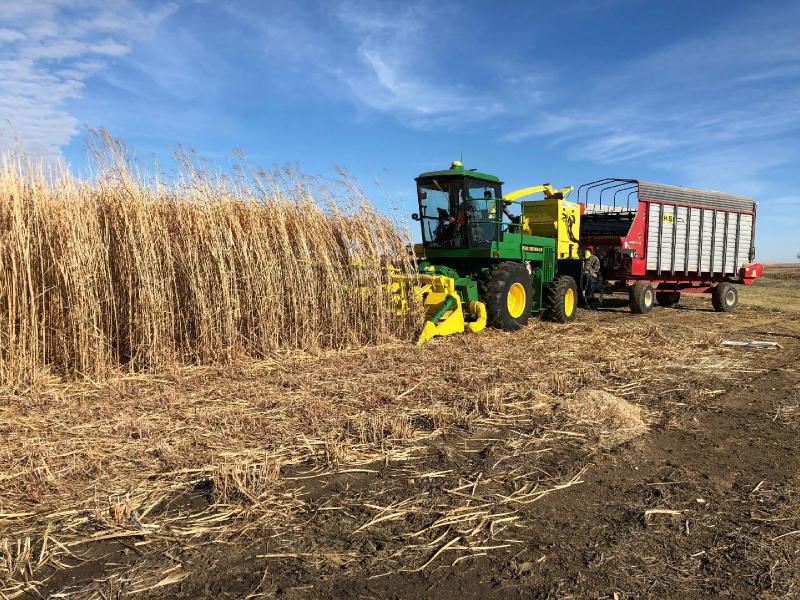A Cost-Effective Solution to Climate Change: Burying Biomass in Dry Landfills
By: Eli Yablonovitch and Harry W. Deckman (SciTechDaily)


The proposed approach is too low-tech to attract attention. No one wants to acknowledge that natural processes can be a solution. And it would be solar powered, to boot.

Lowering the worldwide greenhouse gas emissions is crucial to avoiding a climate disaster, but existing carbon removal techniques are proving to be inefficient and expensive. A team of researchers from the University of California, Berkeley, has come up with a scalable answer that utilizes basic, low-cost technologies to remove carbon from the atmosphere and safely store it for thousands of years.
In a report recently published in the Proceedings of the National Academy of Sciences, the researchers propose a new unique approach to capturing carbon from the air, called agro-sequestration. This method involves growing biomass crops and then burying the harvested vegetation in specially designed dry biolandfills. The buried biomass is kept dry through the use of salt to inhibit microbial activity and prevent decomposition, allowing for the stable sequestration of all the carbon in the biomass.
The result is carbon-negative, making this approach a potential game changer, according to Eli Yablonovitch, lead author and Professor in the Graduate School in UC Berkeley's Department of Electrical Engineering and Computer Sciences.
"We're claiming that proper engineering can solve 100% of the climate crisis, at a manageable cost," said Yablonovitch. "If implemented on a global scale, this carbon-negative sequestration method has the potential to remove current annual carbon dioxide emissions as well as prior years' emissions from the atmosphere."
Unlike prior efforts toward carbon neutrality, agro-sequestration seeks not net carbon neutrality, but net carbon negativity. According to the paper, for every metric ton (tonne) of dry biomass, it would be possible to sequester approximately 2 tonnes of carbon dioxide.
Agro-sequestration: A way to stably sequester carbon in buried biomass
The idea of burying biomass in order to sequester carbon has been gaining popularity, with startup organizations burying everything from plants to wood. But ensuring the stability of the buried biomass is a challenge. While these storage environments are devoid of oxygen, anaerobic microorganisms can still survive and cause the biomass to decompose into carbon dioxide and methane, rendering these sequestration approaches carbon-neutral, at best.
But there is one thing that all life forms require — moisture, rather than oxygen. This is measured by "water activity," a quantity similar to relative humidity. If internal water activity falls below 60%, all life comes to a halt — a concept underpinning the UC Berkeley researchers' new agro-sequestration solution.
"There are significant questions concerning long-term sequestration for many of these recently popularized nature- and agriculturally-based technologies," said Harry Deckman, co-author of the study and a researcher in the Department of Electrical Engineering and Computer Sciences. "The agro-sequestration approach we're proposing can stably sequester the carbon in dried salted biomass for thousands of years, with less cost and higher carbon efficiency than these other air capture technologies."
Hugh Helferty, co-founder and president of Producer Accountability for Carbon Emissions (PACE), a nonprofit committed to attaining global net zero emissions by 2050, sees great promise in this solution. "Agro-sequestration has the potential to transform temporary nature-based solutions into permanent CO2 storage," said Helferty, who is not involved with the study. "By developing their approach, Deckman and Yablonovitch have created an invaluable new option for tackling climate change."
Achieving the right level of dryness to prevent decomposition
Living cells must be able to transfer water-solubilized nutrients and water-solubilized waste across their cell walls to survive. According to Deckman, decreasing the water activity below 60% has been shown to stop these metabolic processes.
To achieve the necessary level of dryness, Yablonovitch and Deckman took inspiration from a long-term food preservation technique dating back to Babylonian times: salt.
"Dryness, sometimes assisted by salt, effectively reduces the internal relative humidity of the sequestered biomass," said Yablonovitch. "And that has been proven to prevent decomposition for thousands of years."
Researchers point to a date palm named Methuselah as proof that biomass, if kept sufficiently dry, can be preserved well beyond the next millennium.
In the 1960s, Israeli archaeologist Yigal Yadin discovered date palm seeds among ancient ruins atop Masada, a mesa overlooking the Dead Sea — one of the most arid places in the world. The seeds remained in a drawer for more than 40 years, until Sarah Sallon, a doctor researching natural medicines, requested them in 2005. After having the seeds carbon-dated, she learned that they were 2,000 years old and then asked horticulturist Elaine Solowey to plant them. They germinated, and Methuselah, one of those date palms, continues to thrive today.
"This is proof that if you keep biomass dry, it will last for hundreds to thousands of years," said Yablonovitch. "In other words, it is a natural experiment that proves you can preserve biomass for 2,000 years."
A cost-effective, scalable approach
In addition to offering long-term stability, Yablonovitch, and Deckman's agro-sequestration approach is extremely cost-effective. Together, the agriculture and biolandfill cost a total of US$60 per tonne of captured and sequestered carbon dioxide. (By comparison, some direct air capture and carbon dioxide gas sequestration strategies cost US$600 per tonne.)
"Sixty dollars per tonne of captured and sequestered carbon dioxide corresponds to an added cost of $0.53 per gallon of gasoline," said Yablonovitch. "At this price, offsetting the world's carbon dioxide emissions would set back the world economy by 2.4%."
The researchers have compiled a list of more than 50 high-productivity plants capable of being grown in diverse climates worldwide and with dry biomass yields in a range from 4 to more than 45 dry tonnes per hectare. All have been selected for their carbon-capturing abilities.
This solution also can scale without encroaching upon or competing with farmland used to grow food. Many of these biomass crops can be grown on marginal pasture and forest lands, or even on farmland that has remained fallow.
"To remove all the carbon that's produced would require a lot of farmland, but it's an amount of farmland that is actually available," said Yablonovitch. "This would be a great boon to farmers, as there is farmland that is currently underutilized."
Farmers harvesting these biomass crops would dry the plants, then entomb them in a dry engineered biolandfill located within the agricultural regions, tens of meters underground and safe from human activity and natural disasters.
The researchers based their design of these dry tomb structures on current municipal landfill best practices, but added enhancements to ensure dryness, such as two 2-millimeter-thick nested layers of polyethylene encasing the biomass, a practice already used in modern landfills.
The landfill area would cover only a tiny portion — 0.0001% — of the agricultural area. In other words, 10,000 hectares of biomass production could be buried in a 1-hectare biolandfill. In addition, the top surface of the landfill could be restored to agricultural production afterward.
A fast path to adoption
The timeline for the adoption of this carbon capture and sequestration method could be short, according to Deckman. "Agro-sequestration is technologically ready, and construction of the engineered biolandfills could begin after one growing season," he said.
Yablonovitch and Deckman's analysis shows that farmers could make the transition to biomass agriculture rather quickly. They estimate that it would take about one year to convert existing farmland to biomass agriculture, but longer for virgin land that lacks the infrastructure needed to support agriculture. The biomass crops would be ready for harvest and sequestration within a growing season.
Using this approach, the researchers calculated that sequestering approximately half of the world's greenhouse gas emissions — about 20 gigatonnes of carbon dioxide per year — would require agricultural production from an area equal to one-fifth of the world's row cropland or one-fifteenth of the land area for all croplands, pastures, and forests. According to their report, this amount of land is the same or less than the total area that many of the Intergovernmental Panel on Climate Change's models for greenhouse reduction are considering for biomass production.
"Our approach to agro-sequestration offers many benefits in terms of cost, scalability, and long-term stability," said Yablonovitch. "In addition, it uses existing technologies with known costs to provide a practical path toward removing carbon dioxide from the atmosphere and solving the climate change problem. Nonetheless, society must continue its efforts toward de-carbonization; developing and installing solar and wind technologies; and revolutionizing energy storage."
Reference: "Scalable, economical, and stable sequestration of agricultural fixed carbon" by Eli Yablonovitch and Harry W. Deckman, 11 April 2023, Proceedings of the National Academy of Sciences.
DOI: 10.1073/pnas.2217695120





Natural processes have been sequestering carbon for billions of years. But those natural processes can't be patented, there isn't a need for academic grants, and humans think they are better than nature. A lawn will extract CO2 from the atmosphere and sequester the carbon, if we let it.
Since the problem we're in now is directly caused by drilling and digging into the ground and bringing previously sequestered carbon to the surface, it only stands to reason that at least part of the solution should be to bury carbon.
But how would this work on a global basis?
And where does all the salt come from?
It's working on a global basis at present. We just don't landfill agri-waste. If farming transitioned to no-till practices then landfilling might not be needed.
Once upon a time, it was common practice to salt hay. It was also common practice to stack hay before mechanized farming came along. For most of human history, harvesting and storage was exactly the same as described in the seeded article.
Unlike other technology based proposals, the salt isn't used to chemically convert carbon dioxide to some other form.